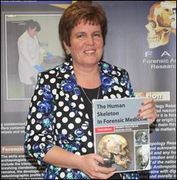Forensic Anthropology Book Launched at The Faculty of Health Sciences
December 13, 2013 (PRLEAP.COM) Education News
Johannesburg, South Africa - Deputy Minister of Health, Dr Gwen Ramokgopa, celebrated the launch of the latest edition of The Human Skeleton in Forensic Medicine authored by Prof Maryna Steyn, a physical anthropologist and the Director of Forensic Anthropology Research Centre, based at the University of Pretoria's Faculty of Health Sciences. She co-authored the book with Mehmet Yasar Işcan from the University of Istanbul, Turkey. The book details discussions on crime scene investigation including excavation techniques and determination of time since death as well as skeletal analysis. The first edition of the book was published by Prof Wilton Marion Krogman from the United States of America in 1960. The book was based on the notes he published in the FBI Law Enforcement Bulletin in 1939 and it served as a guide to the identification of human skeletal material. The second edition of the book followed in 1986 by Prof Krogman and Prof M.Y. Iscan. By then there were few books on the subject of forensic anthropology and it became the gold standard in the field of skeletal identification.
Twenty seven years later, a third edition of the book is produced by Profs Mehmet Iscan and Maryna Steyn, reflecting the developments in the field in the last quarter of the century. In the current edition, existing chapters have all been thoroughly revised. They bring readers up to date with the current concepts of skeletal age; determination of sex; assessment of ancestry; calculation of stature; superimposition and restoration of physiognomy. The book features a chapter on trauma analysis which came as a result of new developments in science, and also a chapter on bone pathology which elucidates the main pathological conditions that can be recognised during the skeletal identification process. DNA analysis from bones is also featured in the book.
There is a new dimension of the book pertinent to modern forensic technology, featuring forensic analysis of the living. This dimension is not so well developed in South Africa and it entails photo identification of the perpetrator who participated in the crime, as well as age estimation.
Prof Maryna Steyn described the book as a standard in the field of forensic anthropology with a South African flavour (because of its local case studies). "Although the book consists of many South African case studies emanating from my experience, we attempted to give it a global perspective, for example where we outlined standards to estimate stature I included data for every continent in the world. The book is also more of a reference text for post-graduate studies in the field of forensic anthropology and pathology," said Prof Steyn.
The Deputy Minister of Health, Dr Gwen Ramokgopa, said the launch of the book is significant not only because of its historic nature, but for research and academia as well as a demonstration of the world-class capabilities of the South African scientists. Deputy Minister Ramokgopa said that forensic pathology and anthropology contributes vastly towards justice in the country.
"There have been advances in forensic pathology and forensic anthropology involving the analysis of medical evidence to produce objective information for use in the legal system. We acknowledged the fact that affirming the importance of forensic medicine is part of celebrating a new era of justice and of recognising the right to dignity for all humanity – whether they are alive or have passed on," she said.
Deputy Minister Ramokgopa cherished the fact that the book is based on the experiences of South Africa. "We can be proud of the fact that the knowledge that we have acquired in South Africa, and the understanding and the interface between medicine and justice we have gathered over the years can be at the service of the world and also beneficial to future generations as they explore in science," she said.
About
UP is the leading research university in South Africa and one of the largest in the country. The university has seven campuses as well as a number of other sites of operation, such as the Pretoria Academic Hospital. Central administration is located at the Hatfield Campus. The University of Pretoria offers more than 1,800 academic programmes in two of the official languages, namely Afrikaans and English. (Some programmes and modules are offered only in English.)
In 1996, the University of Pretoria became the university with the highest research output in South Africa and we have maintained this status. The University of Pretoria celebrated its Centenary in 2008. The academic programmes of the university are offered in nine faculties, as well as a business school. The faculties comprise a total of 140 departments and 85 centres, institutes and bureaus. UP is at the forefront of tertiary education in the country and collaborates with world-class partners to ensure continued excellence in learning and teaching. For more information please go to: http://web.up.ac.za/.


